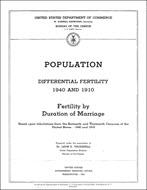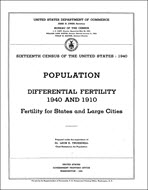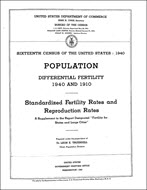1940 Census of Population: Differential Fertility, 1940 and 1910
1940 Census of Population: Differential Fertility, 1940 and 1910
This series of 5 reports are based on sample tabulations of the 1940 and 1910 fertility data. These reports present statistics on social, economic, and other characteristics of whites and Negroes for the United States, including country of birth for the foreign-born white, by regions, urban and rural.
- Fertility by Duration of Marriage
- Fertility by States and Large Cities
- Standardized Fertility Rates and Reproduction Rates. A Supplement to the Report Designated Fertility for States and Large Cities
- Women by Number of Children Ever Born
- Women by Number of Children Under 5 Years Old
Fertility by Duration of Marriage
This report is based on tabulations of samples of the census returns for 1940 and 1910. It presents statistics for native white and Negro women by number of children ever born and duration of marriage in relation to such social and economic characteristics as urban and rural residence, age of woman, education, employment status and major occupation group of husband; and supplementary tables with data showing detailed marital status of native white and Negro women, childless and mothers (by age) with total children ever born.
Practically all work on this subject was laid aside during the war because of shortage of manpower and pressure for other types of statistics required for war purposes. These statistics are useful not only for the study of differential fertility among women married comparable lengths of time but also for the study of differential marriage patterns among women of various groups. Statistics for 1910 are included in order to show the changes in fertility which have occurred in the course of a generation.
Document Sections
Detailed Tables
<h6>United States</h6>
<h6>Regions</h6>
Download Fertility by Duration of Marriage
Fertility for States and Large Cities
This report is based on the tabulation of samples of the census returns for 1940 and for 1910 and presents statistics on the fertility and other characteristics of women for regions, States, cities of 250,000 or more, and metropolitan districts of cities of 1,000,000 or more. This report contains the only statistics published from either census relating directly to the fertility of women for States, cities, and metropolitan districts.
Statistics for 1910 are included in order to show the changes in fertility which have occurred in the course of a generation.
Document Sections
<h5>Detailed Tables</h5>
Download Fertility for States and Large Cities
Standardized Fertility Rates and Reproduction Rates. A Supplement to the Report Designated Fertility for States and Large Cities
This report presents fertility rates (gross and net reproduction rates, intrinsic rate of natural increase by States, intrinsic birth and death rates, mean length of generation by regions) for white and Negro women by urban and rural residence.
There are five appendixes:
- Appendix A—Completeness of Enumeration of Children under 5 years old in the Censuses of 1940 and 1910;
- Appendix B—Proportion of All Children under 5 years old and 5 to 9 years old Represented in Sample C (1940) and Sample W (1910);
- Appendix C—Life-table Stationary Population for Females under 55 years old, 1930 to 1939 and 1909 to 1911;
- Appendix D—Procedure for Computing Gross and Net Reproduction Rates from Age-specific Ratios of Children under 5 years old to Women; and
- Appendix E—Procedure for Computing Average Annual Age-specific Birth Rates from Ratios of Children under 5 years old to Women.
The appended analyses are accompanied by illustrative tables.
Download Standardized Fertility Rates and Reproduction Rates
Women by Number of Children Ever Born
This report presents statistics on number of children ever born to white and Negro women classified by social and economic characteristics of the woman and her family, e.g., detailed marital status, age of woman at marriage, duration of marriage, parentage of woman, region or country of birth of woman, years in the United States, education and literacy of woman, and rental value of home. Appendix—An index of the fertility of women ever married who made no report on the number of children ever born; relative to the fertility of those who did report.
Document Sections
<h5>Detailed Tables</h5>
Download Women by Number of Children Ever Born
Women by Number of Children Under 5 Years Old
This report presents statistics on the fertility of native white and Negro women 15 to 49 years old in the United States, according to social and economic characteristics of the woman and her family. Women are classified by number of children under 5 years old and by age in relation to marital status, parentage, education (last full grade of school completed), migration, birthplace, employment status, and tenure and monthly rental value of home. Women married once are also classified by relationship to the head of the household, occupation of husband, education of husband, and birthplace of husband. Statistics are presented for the United States by regions, urban and rural.
Document Sections
<h5>Detailed Tables</h5>
Women by Number of Children Under 5 Years Old
A Note on Language
Census statistics date back to 1790 and reflect the growth and change of the United States. Past census reports contain some terms that today’s readers may consider obsolete and inappropriate. As part of our goal to be open and transparent with the public, we are improving access to all Census Bureau original publications and statistics, which serve as a guide to the nation's history.










